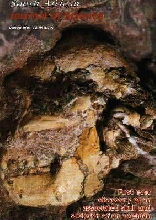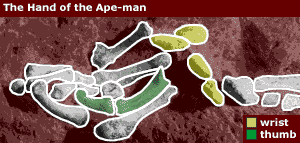Fossil Hominids: Stw 573 (Little Foot)
In 1995, Ronald Clarke and Phillip Tobias announced the discovery of the
fossil Stw 573, nicknamed Little Foot, consisting of four articulating foot
bones from an australopithecine. These bones were actually discovered in
Sterkfontein Cave in the late 1970's, but were only recognized as hominid
when Ronald Clarke found them while looking through a box of miscellaneous
bones in 1994. The bones had human features in the hindfoot, while the
forefoot was very apelike. Although adapted to bipedalism, the big toe
could spread out sideways from the rest of the foot, like chimpanzees but
unlike humans. Clarke and Tobias interpreted this as evidence that Little
Foot had walked bipedally, but also spent a significant amount of time
climbing in trees (Clarke and Tobias 1995, Oliwenstein 1995). Other
scientists, most notably Owen Lovejoy, disagreed, arguing that the
australopithecine hip, knee and spine are all adapted for bipedality, and
that it is "mechanically and developmentally naive" to ignore all this
evidence in favor of one foot joint.
 In 1997, while examining more boxes of bones from Sterkfontein, Clarke
found, over the space of about two weeks, another 8 leg and foot bones from
the same individual. Because one of the bone fragments had a clean break
that looked as though it could have been caused by miners blasting, Clarke
suspected that more bones from the same individual might still be inside
the cave. He asked two of the Sterkfontein preparators to search for a
matching piece of bone in the exposed breccia surfaces of the cave.
Amazingly, they found it, after two days of searching by the light of
hand-held lamps. Further excavations found some more bones, and exposed
the left side of a complete skull. The state of preservation and
positioning of the bones already found indicated that a significant amount
of the rest of the skeleton is probably still inside the rock, waiting to
be extracted. (Clarke 1998)
In 1997, while examining more boxes of bones from Sterkfontein, Clarke
found, over the space of about two weeks, another 8 leg and foot bones from
the same individual. Because one of the bone fragments had a clean break
that looked as though it could have been caused by miners blasting, Clarke
suspected that more bones from the same individual might still be inside
the cave. He asked two of the Sterkfontein preparators to search for a
matching piece of bone in the exposed breccia surfaces of the cave.
Amazingly, they found it, after two days of searching by the light of
hand-held lamps. Further excavations found some more bones, and exposed
the left side of a complete skull. The state of preservation and
positioning of the bones already found indicated that a significant amount
of the rest of the skeleton is probably still inside the rock, waiting to
be extracted. (Clarke 1998)
 By a year later, the bones of an almost complete arm and hand had been
exposed, though not yet excavated from the rock. Clarke is very confident
that more of the skeleton, including the pelvis and spine, remain inside
the rock and can be retrieved. The skeleton was originally thought to be
between 3.0 and 3.5 million years old. Partridge et al. (2003) claimed an
age of 4 million years, which if correct would make Stw 573 one of the oldest
known australopithecine fossils, and easily the oldest from South Africa.
Walker et al. (2006) have determined an age of 2.2 million years.
By a year later, the bones of an almost complete arm and hand had been
exposed, though not yet excavated from the rock. Clarke is very confident
that more of the skeleton, including the pelvis and spine, remain inside
the rock and can be retrieved. The skeleton was originally thought to be
between 3.0 and 3.5 million years old. Partridge et al. (2003) claimed an
age of 4 million years, which if correct would make Stw 573 one of the oldest
known australopithecine fossils, and easily the oldest from South Africa.
Walker et al. (2006) have determined an age of 2.2 million years.
The hand bones of Stw 573 seem to be like those of modern humans in being
relatively unspecialized, having a short palm and fingers compared to
modern apes. They lack the long, strong fingers used by chimps and
gorillas for knucklewalking, and the elongation of the hand found in the
highly arboreal gibbons and orang-utans. However the phalange (finger)
bones which are visible from the side are curved like those of the
Australopithecus afarensis skeleton Lucy, indicating they were
probably used in climbing.
Additionally, Clarke considers that the feet of Stw 573 are a very good
match for the 3.7 million year old footprint trails discovered at Laetoli
by Mary Leakey's team.
Clarke points out (1998) that not only has this fossil yielded the most
complete australopithecine skull yet found, it has been found in
association with the most complete set of foot and leg bones known so far,
with more probably still to be extracted from the rock (and since then, the
arm and hand has been discovered.) In addition, the preservation of the
skeleton is extraordinary, with most of the bones intact and joined
together in their natural position (it is usual for fossil bones to be
broken, often into small pieces, and for bones to get separated and
scattered).
Clarke is not yet prepared to say which species it belongs to, except that
it does appear to be an australopithecine. However, even from the bones
that have been revealed so far, Little Foot looks like being at least as
complete and important as Lucy, and will add tremendously to our knowledge
of australopithecines. If Clarke's expectations of further finds are borne
out, Little Foot could become the most spectacular and important hominid
fossil ever discovered, rivalled only by the Turkana
Boy Homo erectus skeleton.
References
Clarke R.J. and Tobias P.V. (1995): Sterkfontein member 2 foot bones of the
oldest South African hominid. Science, 269:521-4.
Clarke R.J. (1998): First
ever discovery of a well-preserved skull and associated skeleton of
Australopithecus. South African Journal of Science, 94:460-4.
Clarke R.J. (1999): Discovery of the complete arm and hand of the 3.3 million-year-old
Australopithecus skeleton from Sterkfontein. South African
Journal of Science, 95:477-80.
Morris J.D. (1995): What distinguishes man
from ape? Acts & Facts, 24.11:d (a creationist commentary)
Partridge T.C., Granger D.E., Caffee M.W., and Clarke R.J. (2003): Lower Pliocene hominid remains from Sterkfontein. Science, 300:607-12.
Oliwenstein L. (1995): New foot steps into walking debate. Science,
269:476-7. (Commentary on Clarke and Tobias 1995)
Walker, J., Cliff, R.A., Latham, A.G. (2006): U-Pb Isotopic Age of the StW 573 Hominid from Sterkfontein, South Africa. Science, 314:1592-4.
Links
Fossil find could rewrite human history, from BBC News, December 1998
African ape-man's hand unearthed, from BBC News, December 1999
Fossil find stirs human debate, from BBC News, January 2003
This page is part of the Fossil Hominids FAQ at the talk.origins Archive.
Home Page |
Species |
Fossils |
Creationism |
Reading |
References
Illustrations |
What's New |
Feedback |
Search |
Links |
Fiction
http://www.talkorigins.org/faqs/homs/littlefoot.html, 04/30/2003
Copyright © Jim Foley
|| Email me 
 In 1997, while examining more boxes of bones from Sterkfontein, Clarke
found, over the space of about two weeks, another 8 leg and foot bones from
the same individual. Because one of the bone fragments had a clean break
that looked as though it could have been caused by miners blasting, Clarke
suspected that more bones from the same individual might still be inside
the cave. He asked two of the Sterkfontein preparators to search for a
matching piece of bone in the exposed breccia surfaces of the cave.
Amazingly, they found it, after two days of searching by the light of
hand-held lamps. Further excavations found some more bones, and exposed
the left side of a complete skull. The state of preservation and
positioning of the bones already found indicated that a significant amount
of the rest of the skeleton is probably still inside the rock, waiting to
be extracted. (Clarke 1998)
In 1997, while examining more boxes of bones from Sterkfontein, Clarke
found, over the space of about two weeks, another 8 leg and foot bones from
the same individual. Because one of the bone fragments had a clean break
that looked as though it could have been caused by miners blasting, Clarke
suspected that more bones from the same individual might still be inside
the cave. He asked two of the Sterkfontein preparators to search for a
matching piece of bone in the exposed breccia surfaces of the cave.
Amazingly, they found it, after two days of searching by the light of
hand-held lamps. Further excavations found some more bones, and exposed
the left side of a complete skull. The state of preservation and
positioning of the bones already found indicated that a significant amount
of the rest of the skeleton is probably still inside the rock, waiting to
be extracted. (Clarke 1998)
 By a year later, the bones of an almost complete arm and hand had been
exposed, though not yet excavated from the rock. Clarke is very confident
that more of the skeleton, including the pelvis and spine, remain inside
the rock and can be retrieved. The skeleton was originally thought to be
between 3.0 and 3.5 million years old. Partridge et al. (2003) claimed an
age of 4 million years, which if correct would make Stw 573 one of the oldest
known australopithecine fossils, and easily the oldest from South Africa.
Walker et al. (2006) have determined an age of 2.2 million years.
By a year later, the bones of an almost complete arm and hand had been
exposed, though not yet excavated from the rock. Clarke is very confident
that more of the skeleton, including the pelvis and spine, remain inside
the rock and can be retrieved. The skeleton was originally thought to be
between 3.0 and 3.5 million years old. Partridge et al. (2003) claimed an
age of 4 million years, which if correct would make Stw 573 one of the oldest
known australopithecine fossils, and easily the oldest from South Africa.
Walker et al. (2006) have determined an age of 2.2 million years.
